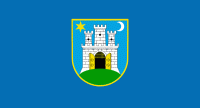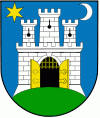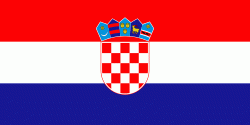City of Zagreb (Grad Zagreb)
 |
 |
Zagreb is a city with a rich history dating from Roman times. The oldest settlement in the vicinity of the city was the Roman Andautonia, in today's Ščitarjevo. The historical record of the name "Zagreb" dates from 1134, in reference to the foundation of the settlement at Kaptol in 1094. Zagreb became a free royal city in 1242. In 1851 Janko Kamauf became Zagreb's first mayor.
Zagreb has special status as a Croatian administrative division - it comprises a consolidated city-county (but separate from Zagreb County), and is administratively subdivided into 17 city districts. Most of the city districts lie at a low elevation along the valley of the river Sava, but northern and northeastern city districts, such as Podsljeme and Sesvete districts are situated in the foothills of the Medvednica mountain, making the city's geographical image quite diverse. The city extends over 30 km east-west and around 20 km north-south. Zagreb ranks as a global city, with a Beta − rating from the Globalization and World Cities Research Network.
The transport connections, concentration of industry, scientific, and research institutions and industrial tradition underlie its leading economic position in Croatia. Zagreb is the seat of the central government, administrative bodies, and almost all government ministries. Almost all of the largest Croatian companies, media, and scientific institutions have their headquarters in the city. Zagreb is the most important transport hub in Croatia: here Central Europe, the Mediterranean and Southeast Europe meet, making the Zagreb area the centre of the road, rail and air networks of Croatia. It is a city known for its diverse economy, high quality of living, museums, sporting, and entertainment events. Major branches of Zagreb's economy include high-tech industries and the service sector.
The etymology of the name Zagreb is unclear. It was used for the united city only from 1852, but it had been in use as the name of the Zagreb Diocese since the 12th century and was increasingly used for the city in the 17th century. The name is first recorded in a charter by archbishop of Esztergom Felician, dated 1134, mentioned as Zagrabiensem episcopatum.
The older form of the name is Zagrab. The modern Croatian form Zagreb is first recorded in a 1689 map by Nicolas Sanson. An even older form is reflected in Hungarian Zabrag (recorded from c. 1200 and in use until the 18th century). For this, Hungarian linguist Gyula Décsy proposes the etymology of Chabrag, a well-attested hypocorism of the name Cyprian. The same form is reflected in a number of Hungarian toponyms, such as Csepreg.
The name might be derived from Proto-Slavic word *grębъ which means hill, uplift. (However, note Serbo-Croatian brȇg < Proto-Slavic *bergъ, which also means '(smaller) hill', and za brȇg 'to or toward the hill' for the seemingly metathesized variant in Hungarian, Zabrag – possibly modified from assumed *Zabreg because of Hungarian vowel harmony.) An Old Croatian reconstructed name *Zagrębъ is manifested through the German name of the city Agram.
The name Agram was used in German in the Habsburg period; this name has been classified as "probably of Roman origin" but according to Décsy (1990) it could be an Austrian German reanalysis of *Zugram. In Middle Latin and Modern Latin, Zagreb is known as Agranum (the name of an unrelated Arabian city in Strabo), Zagrabia or Mons Graecensis (also Mons Crecensis, in reference to Grič (Gradec)).
In Croatian folk etymology, the name of the city has been derived from either the verb za-grab-, meaning "to scoop" or "to dig". One folk legend illustrating this derivation ties the name to a drought of the early 14th century, during which Augustin Kažotić (c. 1260–1323) is said to have dug a well which miraculously produced water. In another legend, a city governor is thirsty and orders a girl named Manda to "scoop" water from the Manduševac well (nowadays a fountain in Ban Jelačić Square), using the imperative: Zagrabi, Mando! ("Scoop, Manda!").
Map - City of Zagreb (Grad Zagreb)
Map
Country - Croatia
Currency / Language
| ISO | Currency | Symbol | Significant figures |
|---|---|---|---|
| HRK | Croatian kuna | kn | 2 |
| ISO | Language |
|---|---|
| HR | Croatian language |
| SR | Serbian language |


















